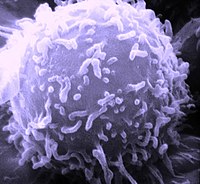
Photo from wikipedia
Objective The aim of this study was to assess the therapeutic effects of biological DMARDs (bDMARDs) on the diversity of immune cell phenotypes in peripheral blood of patients with RA.… Click to show full abstract
Objective The aim of this study was to assess the therapeutic effects of biological DMARDs (bDMARDs) on the diversity of immune cell phenotypes in peripheral blood of patients with RA. Methods Peripheral immune cell phenotypes were determined in 108 RA patients who were non-responsive to conventional DMARDs and 33 healthy control subjects by eight-colour flow cytometry. We also examined the correlation between the phenotypes and clinical findings and assessed the effects of 24-week treatment with bDMARDs. Results The proportions of T follicular helper (Tfh) cells, IgD- CD27- double negative B cells and plasmacytoid dendritic cells (pDCs) were higher in patients with active RA than in healthy control. The percentages of memory T cells, Th17 and Tfh cells correlated with autoantibody titres, whereas that of plasmablasts correlated with disease activity scores. Treatment with TNF inhibitors reduced the proportion of pDCs, while tocilizumab reduced the proportion of double-negative B cells but increased naïve and activated Treg cells. Abatacept treatment resulted in marked decrease in the proportion of activated Tfh but slightly reduced Th17 and Treg cells. The proportion of Tfh cells was an independent and significant predictor of the response to abatacept therapy. Conclusion Molecular targeted therapies induced different changes in different immune cell phenotypes. Among the phenotypes, Tfh cells seem a potential target for abatacept. Immunophenotypic analysis might be useful for prediction of the response to bDMARDs.
Journal Title: Rheumatology
Year Published: 2018
Link to full text (if available)
Share on Social Media: Sign Up to like & get
recommendations!